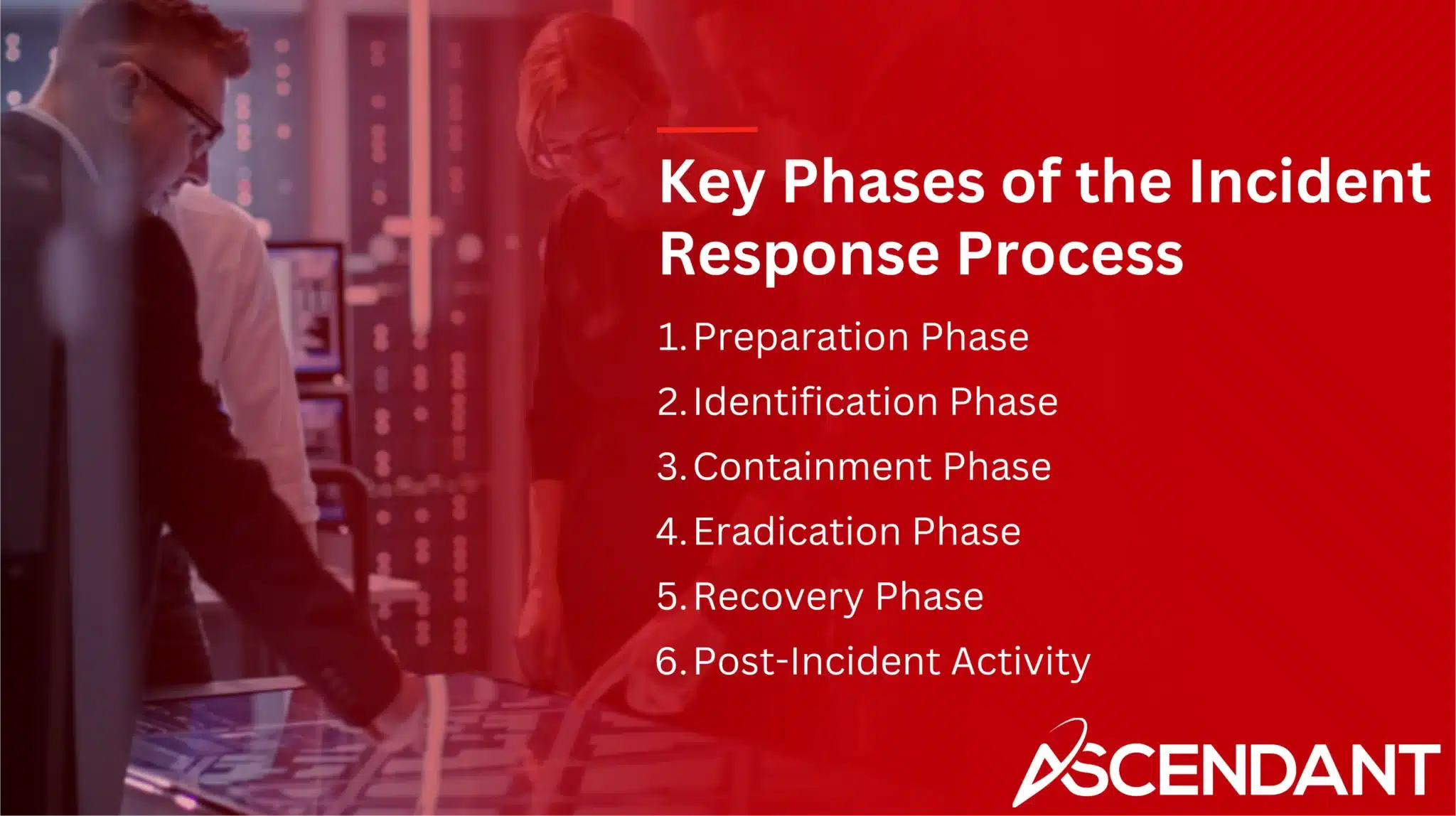Being prepared for a security incident is essential, as these occurrences can happen without warning. It’s vital to understand the necessary steps of incident response in order to minimize harm and facilitate prompt recovery. This guide covers all critical stages: preparation, identification, containment, eradication, recovery, and post-incident analysis. A rapid and efficient reaction helps maintain your organization’s security integrity.
In This Article:
- Understanding Incident Response
- Key Phases of the Incident Response Process
- Building an Effective Incident Response Team
- Tools and Techniques for Incident Response
- Continuous Improvement in Incident Response
- Business Continuity and Incident Response
- Outsourcing Incident Response: Pros and Cons
Key Takeaways
- A well-defined incident response plan is essential for minimizing financial losses and maintaining reputation during security incidents.
- The incident response process consists of six key phases: preparation, identification, containment, eradication, recovery, and post-incident activity, each crucial for effective management of security breaches.
- Continuous improvement and integration of incident response with business continuity planning are vital to enhance organizational resilience against evolving cyber threats.
Understanding Incident Response
Incident response is a systematic method for addressing and managing the aftermath of security events, which can range from cyber breaches to natural disasters and system downtimes. It plays a critical role in reducing financial damage and protecting an organization’s reputation during such incidents. The significance of having a precise incident response plan is immense as it provides clear guidance on responsibilities, roles, and procedural steps that should be taken when faced with turmoil resulting from an incident.
A truly effective incident handling strategy does more than just deal with immediate threats. It protects digital assets while keeping business operations running smoothly. Rapidly executing a coordinated reaction minimizes both operational disruption and potential financial losses while preserving the company’s image. Exhibiting strong security measures alongside customer care through adept management of incidents greatly enhances consumer confidence—this is particularly true in case there’s been exposure to cybersecurity issues.
Without a detailed security incident response plan at hand, organizations might face dire consequences due to mishandling or exacerbated impacts amidst security violations. Key elements for developing an encompassing approach include established protocols for reporting occurrences promptly along with comprehensive checklists catering to extensive responses. Expedient yet competent resolution stands as fundamental support in upholding a sturdy defensive stance against attacks as well as gearing up ahead for any eventual future disturbances.
Key Phases of the Incident Response Process
The incident response lifecycle is comprised of six essential stages: preparation, identification, containment, eradication, recovery and post-incident activity. It’s imperative to grasp the goals and responsibilities associated with each stage in order to devise an effective incident response plan that can mitigate the effects of cybersecurity incidents.
The groundwork for any successful strategy begins with preparation by establishing plans and organizing resources. The next step is identification, spotting potential security breaches and evaluating them accordingly. Containment serves as a means to limit the expansion of such incidents while striving to lessen their impact. Subsequently, eradication focuses on eliminating the underlying cause. Meanwhile recovery works towards reinstating system functionality back to its pre-incident state, encompassing all measures from containment through eradication up until complete restoration.
Finally comes the post-incident activity which emphasizes drawing lessons from what transpired in an effort to bolster future defense mechanisms against similar occurrences. A closer examination into these individual phases will provide us greater insight into their particular importance and intricacies within this process.
\
Preparation Phase
Preparation forms the foundation of effective incident response, involving the development of policies, procedures, tools, and an incident response plan. A well-documented and regularly tested plan, defined team roles and responsibilities, staff training in incident response procedures, and established communication strategies are key elements of this phase.
Simulating potential incidents regularly uncovers gaps in response protocols and boosts preparedness. Automation in response tasks enhances efficiency, while vulnerability management tools identify and mitigate risks within an organization’s infrastructure.
Metrics evaluation of incident detection and resolution refines strategies and ensures strong preparedness.
Identification Phase
The identification phase is essential, as it involves persistent surveillance and examination of data to uncover irregularities that may indicate a security breach. In this phase, sophisticated detection tools like intrusion detection systems (IDS) and Security Information and Event Management (SIEM) solutions are instrumental.
It’s vital to differentiate actual threats from false alarms when evaluating indicators of potential compromise (IOCs). To strengthen this phase, ongoing education and cutting-edge security measures are imperative. By identifying early signs and symptoms swiftly, small deviations can be stopped before they develop into significant events.
Containment Phase
The containment phase restricts the incident’s spread and minimizes its overall impact. Swift containment measures are vital to minimize damage and limit further harm. Isolating affected systems and blocking malicious traffic are effective short-term strategies.
Avoid deleting malware during containment to preserve investigation capabilities. Network segmentation isolates affected areas, helping to minimize breach impact. Effective containment requires balancing strong defensive actions with maintaining essential business functions.
Eradication Phase
Eliminating the underlying issue behind an incident is critical, encompassing tasks such as removing malware, sealing security gaps, changing passwords, and reconstructing systems. Precise orchestration and thorough record-keeping are essential to guarantee that no traces of the hazard remain.
It’s crucial to return systems impacted by the incident back to their initial setup. This step prepares these systems for a secure restoration process while maintaining system integrity. As part of enduring tactics, implementing security updates and keeping evidence intact are also important actions.
Recovery Phase
The primary goal of the recovery phase is to restore systems and operations to a normal state. Restoring systems, testing, monitoring for normal functionality, and ensuring no security loopholes are key actions. Trusted recovery includes verifying software and data integrity, using clean backups, applying patches, and testing.
The recovery process ensures systems are secure and functional before fully restoring operations. A well-documented process and close collaboration with the incident response team ensure a smooth return to normalcy.
The damage extent can influence the recovery process’s duration and effort.
Post-Incident Activity
It’s crucial for organizations to engage in post-incident activities as they are instrumental in fostering learning and enhancing future response capabilities. Conducting post-mortem exercises following incidents enables companies to bolster their defenses by gleaning insights from what transpired.
To promote a thorough comprehension and ongoing advancement, it is essential to include all pertinent stakeholders in meetings aimed at discussing lessons learned. Through the meticulous documentation of these lessons and revising the existing response plan, one can diminish the chances of analogous incidents occurring again. It is particularly critical to pinpoint and tackle the root cause with a view toward averting repeat occurrences.
Building an Effective Incident Response Team
Having a competent incident response team in place is crucial for maintaining a strong incident response process. This team should include technical personnel, coordinators who manage incidents, and delegates from different sectors of the business. The size and configuration of this team can differ based on the specific requirements of an organization and how often incidents occur.
To ensure that members are ready to handle real-life situations, consistent training drills are vital. Having detailed operational guides helps facilitate efficient handling of typical types of incidents. An effective strategy relies heavily on the seamless coordination within the response team.
Tools and Techniques for Incident Response
A robust toolkit is essential for effective incident response. Key tools include:
- SIEM systems
- EDR tools
- Forensic tools
- Collaboration platforms
- Threat intelligence platforms
These tools enhance network security by facilitating monitoring, alerting, and system quarantine.
Integrating threat intelligence enhances automated incident investigations and provides contextual data for endpoints. Advanced tools like Exabeam and CrowdStrike significantly improve threat detection capabilities. Engaging external expertise provides immediate access to specialized knowledge and advanced technology, improving outcomes.
Continuous Improvement in Incident Response
For an effective incident response, it’s crucial to maintain a cycle of continuous improvement. Plans must be regularly updated and revised in order to stay aligned with the ever-changing landscape of cyber threats. Actively engaging in testing, assessing, and enhancing the response plan is essential for competent management.
Evaluating these plans can be achieved through methods such as tabletop exercises, parallel tests, and assessments of tools used during incidents. It is recommended that you review your incident response plans at least once a year to confirm their adequacy. Incorporate lessons learned from past incidents into recovery strategies to reduce potential future risks effectively.
Business Continuity and Incident Response
By implementing incident response measures, companies are protected against cyber threats and can ensure ongoing operations. When business continuity plans include incident response strategies, organizations enhance their capabilities to manage security breaches efficiently. Unified efforts between disaster recovery and incident response personnel lead to a more collaborative approach in handling cybersecurity challenges.
There is a strong connection between incident response and business continuity since both strive to maintain operational functionality amid disruptive events. To keep an effective defense against the ever-changing threat environment, it’s vital that organizations continuously update their incident response tactics.
Outsourcing Incident Response: Pros and Cons
Contracting external services for incident response can lead to uniform outcomes, reduce the effect on operations, and accelerate restoration processes. Such an approach brings forth specialized expertise and access to cutting-edge technology that markedly enhances resolution efficiency. Due to their focused resources and amassed experience, outsourced teams are able to provide swifter responses.
Nevertheless, there are potential negatives such as a lack of intimate knowledge regarding the unique setup or ethos of the hiring organization. Dependence on outside personnel coupled with possible communication issues in urgent situations also poses risks. It is crucial for enterprises to carefully consider both advantages and disadvantages while choosing an appropriate service provider for outsourcing their incident response efforts.
 Summary
Summary
To mitigate the effects of security incidents effectively, it is vital to have a well-crafted incident response plan in place. This involves grasping the essential stages of the incident response lifecycle, assembling a skilled team capable of responding to such incidents, and employing sophisticated tools to aid their efforts. Enhancing this plan with continuous improvement measures and integrating it into overall business continuity strategies significantly bolsters an organization’s defense against cyber threats.
Organizations that employ an all-encompassing strategy for incident response help protect their digital assets while ensuring uninterrupted business operations and preserving customer confidence. The strength of an organization’s defenses lies not only in its ability to react to incidents as they arise, but also in its commitment to learning from these events and perpetually refining its approach based on those lessons learned.
Frequently Asked Questions
What are the 4 incident response plans?
The four phases of an effective incident response plan, as outlined by the National Institute of Standards and Technology (NIST), include preparation, detection and analysis, containment, eradication, and recovery, followed by post-incident activity.
This structured approach is essential for managing and mitigating incidents efficiently.
What are the 7 steps in incident response?
The seven steps in incident response are: prepare for threats, detect the threat, analyze/identify the threat, contain the threat, eliminate the threat, recover and restore, and conduct an incident debrief to learn lessons.
Following these steps ensures a comprehensive approach to managing security incidents effectively.
What is incident response?
Incident response is a structured methodology focused on detecting, responding to, and recovering from security incidents to minimize operational impact and ensure business continuity.
Why is an incident response plan important?
An incident response plan is crucial as it minimizes financial losses and reputational damage by outlining a structured approach for effectively managing security incidents.
Having such a plan ensures swift and coordinated actions when threats arise.
What are the key phases of the incident response process?
Each critical stage of the incident response process, which includes preparation, identification, containment, eradication, recovery and post-incident activity, is vital for efficiently handling and reducing the impact of incidents.

